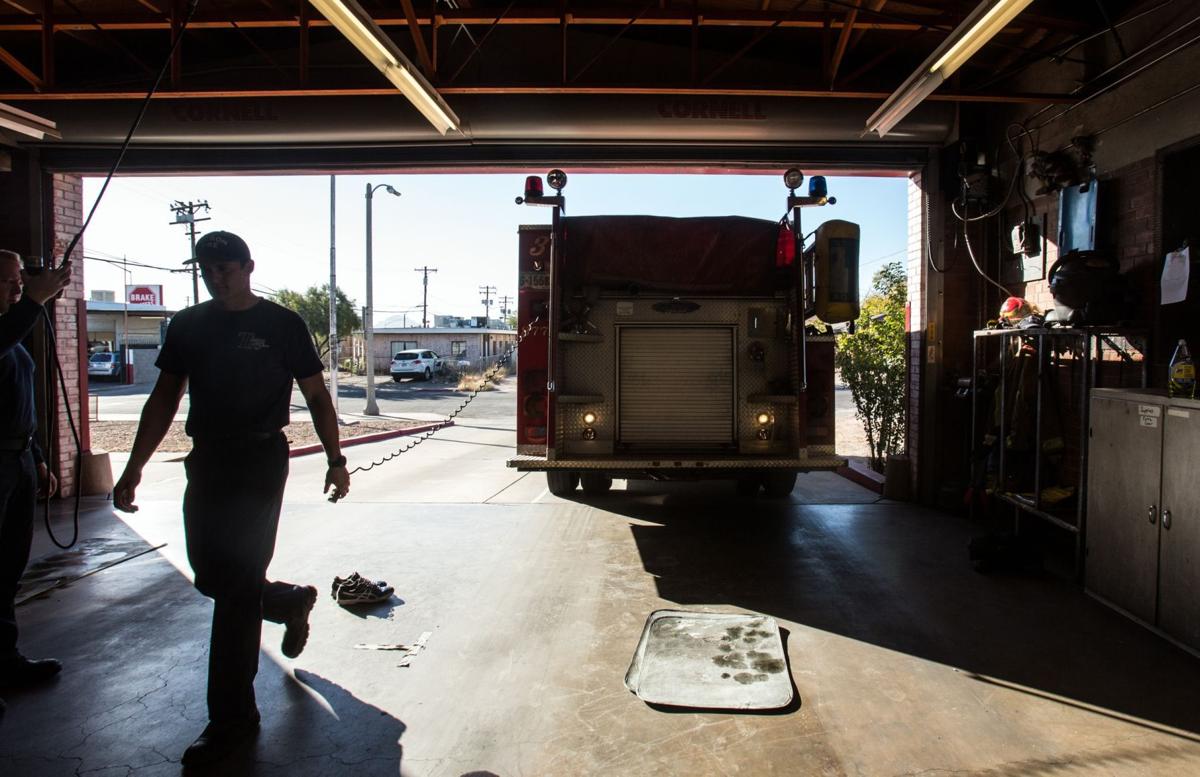A pipe-and-drum corps played “Amazing Grace” as pallbearers in uniform walked the casket of firefighter Jose Samaniego out of Saint Augustine Cathedral Monday morning.
It was a beautiful, sad scene. The Golder Ranch firefighter was so young, just 33, when he died of a sudden illness last week. The outpouring from Arizona firefighters was impressive: Men and women in dark uniforms lined the pews of the full cathedral, and fire trucks from around Southern Arizona lined South Stone Avenue outside. They stood at attention in a “wall of honor” outside the cathedral as Samaniego’s casket was wheeled away.
The scene fit with the public image of firefighters: honorable, loyal, dedicated to service.
But it clashed horribly with the news that came up on my phone as I left the church. A few blocks away, in Pima County Superior Court, a judge had sentenced former Tucson fire Capt. David Watson to 66 years in prison for killing his wife in 2000 and his wife’s mother and her friend in 2003.
That sentencing, of course, came after the even more-shocking news Friday night — that a beloved local fire captain, Fred Bair, opened fire inside a Catalina Foothills restaurant, Firebirds at La Encantada, killing one man, injuring Bair’s ex-wife, and killing himself. In doing so, he also terrified a restaurant full of patrons and employees.
The three incidents — the funeral, sentencing and murder-suicide — share only one real common strand. They all involved firefighters.
Whether that is essential or even relevant to Friday night’s violence is open for debate.
Tucson Fire Chief Jim Critchley did not accept an invitation for an interview. However, I spoke Tuesday with Aaron Haworth, a longtime colleague of Bair’s who works as a paramedic for Rural Metro. He, like many local first-responders, has been ruminating about the shocking shootings by a man they did not imagine was capable of such an act.
Haworth spent much of Sunday and Monday talking to people and engaging on Facebook over the issues he saw lurking behind Bair’s actions. A career in emergency medical response exposes you to so much poisonous stress that it accumulates inside you, he said. PTSD may result, or it may be some less-specific problem — stress, malaise, agitation.
“I’m reaching that point where I’m tired of pretending it doesn’t exist anymore,” he said. “I was completely in denial or unprepared for the psychic debt I was going to have to pay later in life.
“If you live your life running on an ambulance, you’ve got a shelf life,” he said.
That’s true of many firefighters, but the persistently macho culture of the fire service still tells firefighters to be tough in the face of it all. When Haworth saw that Bair had gone off as he did, this is what he perceived as likely explaining it — not justifying it, but explaining it: the accumulation of trauma and stress inside a career firefighter’s body.
Maybe that’s the explanation, or part of it. But then how do we explain that George Majewski, 62, killed his veterinarian wife, Kerman Dubash, 50, on the far northwest side in 2015? And how about Marc Florio, 48, killing Natalie Beissel, a 32-year-old, fourth-year medical resident in 2015? And how do we explain why Darius Solis, 23, killed his mother, Ana Solis, and aunt, Jeneatte Hernandez, then himself in Marana last year? And how about Manuel Encinas, 26, killing his girlfriend, Christine Betancourt, in February, then going armed to a Circle K on South Nogales Highway before being killed by deputies in an apparent suicide-by-cop?
These are just some of the domestic-violence killings that have happened around here in the last two years. The Arizona Coalition to End Sexual and Domestic Violence counted 100 deaths statewide from domestic violence in 2016. Thirteen of those happened in Pima County. That’s about one domestic-violence-related death per month, though often they happen in pairs, as murder-suicides.
What differentiates Bair’s attack on Eliot Cobb and Mary Jo Bair were three factors: It happened in a restaurant, the restaurant was in an upscale mall, and Bair was a somewhat well-known local firefighter. But those factors don’t necessarily mean it was so different from the 13 deaths last year or the many in years before that.
“When it happens in a place like we wouldn’t expect, like a restaurant in a high-end mall — it’s a little more jarring,” Vanessa Helms, the director of Homicide Survivors, told me Tuesday. “We as a society place value on crimes and the severity of them based on their location.”
In other words, people are more interested when these crimes happen among rich or high-status people. But that’s not really so uncommon.
“It happens in all socioeconomic categories and geographic areas,” Ed Mercurio-Sakwa, CEO of the Emerge Center against Domestic Abuse, said Tuesday. “It involves people with impressive titles who might do amazing things in other parts of their lives.”
“We’re not of the belief that it’s a firefighter problem,” he went on. “There are some conversations that could be had around masculinity and how that gets defined in our society.”
Men who want to control women are those who sometimes escalate their controlling behavior until they commit murder, Mercurio-Sakwa said. It could be that mentality is more common in macho fire-department cultures. But maybe not — society certainly has enough mental crises and domestic violence to produce a tragically long list of these deaths among civilians every year.
The fact that a local firefighter did it again — 14 years after the last time — doesn’t necessarily mean we have a firefighter problem. But we definitely have a persistent, dangerous domestic-violence problem.





